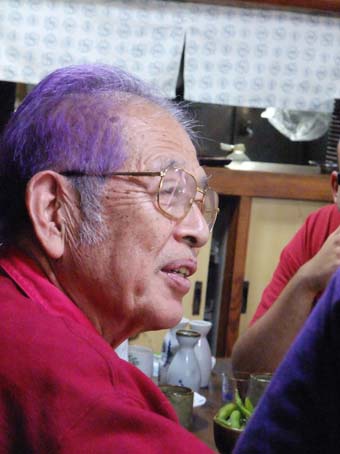From Paart Budo Buki by buki stolar
and this was before back paint, so it could be also natural wood or brown, red etc.
… Read More
From Paart Budo Buki by buki stolar
From Paart Budo Buki by buki stolar
From Shiro Kuma's Weblog by kumafr
 The Bujinkan is growing in quantity but it seems to me that some of its original qualities tend to disappear. And 尊敬心 sonkeishin (respect) seems to be the first one on the list of endangered qualities.
The Bujinkan is growing in quantity but it seems to me that some of its original qualities tend to disappear. And 尊敬心 sonkeishin (respect) seems to be the first one on the list of endangered qualities.
I train Bujinkan because I deeply respect our Sôke Hatsumi Masaaki. The respect I feel for him has nothing to do with the arts he is teaching or showing us but with the man he his. I have been in contact with a few “great men” in my life but none, so far, has been able to mould me and influence me the way he did. I am who I am because I had the privilege to meet Sensei in July 1987 at the first European Taikai organized by Peter.
That was nearly 25 years ago (more than half my age) and through Hatsumi sensei’s permanent teachings (martial and non martial) I was trained to become a true human being.
The Bujinkan Arts mainly develop one feeling and this is intuition. The Sakki test is the pragmatic proof that one has reached this level of intuition.
In Latin, “intuition” is “intuitus” and means the “act of looking at things”. Our Bujinkan training develops our “vision” and we gradually become able to see or “sense” any situation better than many others. The sixth sense is common to all living creature but is rarely accessible to humans. Luckily, the long hours of strenuous training unearth it from within our brain and makes it available to us. Through Hatsumi sensei’s teachings we learn to become more intuitive, i.e. aware of things without apparently thinking. “Don’t think!” as he often say it in class.
Intuition is also 感覚 kankaku in Japanese and means “feeling”. The more we “feel” (through our 5 senses) and the more we develop our sixth sense.
Now funnily, the word 尊敬心 sonkeishin (respect) is somehow linked to the way at which we look at things. But as “kankaku” exists only in the present, “sonkeishin” is linked to the past.
To respect someone is to look at someone’s actions in the past. The Online Etymology Dictionary says it comes “from Latin respectus ”regard,” literally “act of looking back at one,” pp. of respicere ”look back at, regard, consider”.
What someone has achieved in his life is what creates respect. But the Bujinkan growing in quantity I have the intuition that less respect is shown to the elders. Remember that you are who you are because these elders made it possible for you. Look at how Sensei speaks about Takamatsu sensei. This is how you should feel about those who shared with you what you are so proud to have today. Getting a Jûgodan doesn’t free yourself from sonkeishin, on the contrary.
With time some arguments, disagreements, and fights might appear with your elders, but you should never show a lack of sonkeishin to them.
If you do so then 尊敬心 sonkeishin (respect) will turn into 損敬神 sonkeishi (loss of reverence) and the Bujinkan magic will be lost.
Thank you Sensei for your guidance all through these years, and for your help to become an adult.
Respectfully, your student Arnaud
From Shiro Kuma's Weblog by kumafr
 After 5 years (plus one week) you have visited this blog over 250,000 times!
After 5 years (plus one week) you have visited this blog over 250,000 times!
It is a quarter of a million! and represents 50,000 visits per year. This is something we can proud of. Thank you!
During all these years I tried to deliver, through my articles, my feelings about the Bujinkan and all the “secrets” I could get from Hatsumi sensei’s teachings.
I have the chance to go to Japan three times a year I created this blog primarily to help those of you who cannot travel to Noda as often as you would like, so that through these articles you could get a glimpse of what sensei is teaching in his classes.
Even if this is my interpretation, I will continue as I have the feeling that it is helping many Bujinkan members.
This blog is now available in 4 languages and I want to thank here the translators. First of all is my friend Elias who has been doing that for a long time and who is the first one to translate the articles. And also Christophe and Raphael who began to translate them too. Thank you guys I deeply appreciate your help.
Now I have a message for you the reader. Many of your buyû are not able to read English so why don’t you volunteer and translate them into your own language? Send them to me and put them also on your own website. There is nothing to gain here except maybe the pleasure to do something useful for our warrior community.
Contact me if you want to be part of it and help us build a stronger Bujinkan. Remember that information is power.
Thank you again “merci beaucoup” for your endless support.
Arnaud Cousergue
Bujinkan Shihan
From Shiro Kuma's Weblog by kumafr
In the Bujinkan there is the concept of 劒体一条 ken tai ichijô (body and weapon are one).
This concept makes a lot of sense when wielding a heavy sword in 片手 katate (one hand) because the free arm is often in the way. And this is even more difficult to manage as the blade is double edged.
We discovered this same problem when we studied the Tachi. But with the Ken this is even more accurate.
In the Kukishin ryû one of the kotsu is to “keep the elbows/arms close to the body”, this is for the same reason. If you train with the 万力鎖 manriki gusari this is also mandatory.
When I was stationed in Lebanon for the UN, I attended a very interesting Kukri* demonstration by the Nepalese Army. It was impressive and I noticed that the 200 soldiers moving in unisson always kept their free arm off the weapon for themselves and also for their neighbours. I took a video that I might post here one day.
So, as we are discovering the Ken, please keep your free arm as close as possible to the body at all time. Whatever you do with a new weapon has to begin slow. The first achievement is to avoid getting injured by it.
Confidence and ease are the natural results of heavy and long rehearsal. So please train slowly your katate movements, they are very powerful and devastating with such a heavy sword. Your security (and the one of your neighbours) should always be your first concern in training. Don’t be too presomptuous about your own abilities, learn step by step, and keep your free arm to your body.
If you don’t pay attention and don’t learn these movements correctly in slow motion then, instead of 劒体一条 ken tai ichijô, we will do 献体一冗 kentai ichijô, and ”give your useless body to a hospital for medical research”. Interested?
*The khukuri (Nepali: खुकुरी) (alternatively spelled khukri or kukri) is a Nepalese knife with an inwardly curved edge, used as both a tool and as a weapon.For more information check THIS Wikipedia page.
**This is also valid for any object or weapon.
NB: In a previous post I wrote about the weakness of the wooden Taichi sword that can break easily when stopping an attack in the dôjô. Those of you using one, add a layer or two of duct tape and it will increase the security and lower the risks of injury during training. Also it will add a little more weight which is even better.